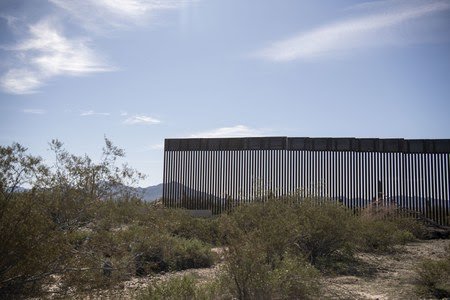
TUCSON, Ariz. – The contractor that is building President Donald Trump’s border wall in southwestern Arizona began blasting this week through a site that the Native American O’odham people consider sacred to make way for newer, taller barriers.
U.S. Customs and Border Protection confirmed the contractor started blasting through the site called Monument Hill at Organ Pipe Cactus National Monument west of Lukeville “in preparation for new border wall system construction within the Roosevelt Reservation.”
The Roosevelt Reservation is a 60-foot-wide swath of federally owned land along the border in Arizona.
Since construction began in August, crews have been clearing that 60-foot swath – relocating certain plants, including the state’s iconic saguaros, to other parts of the national park.
Monument Hill is west of the Lukeville border crossing and lies partly within the 60-foot reservation. The other portion is on the Mexican side of the border.
“The controlled blasting is targeted and will continue intermittently for the rest of the month,” the border agency said in a statement. “U.S. Customs and Border Protection will continue to have an environmental monitor present during these activities as well as on-going clearing activities.”
Monument Hill is one of several sites of archaeological and cultural significance to the O’odham people that is in the path of border wall construction.
Tohono O’odham Nation Chairman Ned Norris Jr. declined to comment about the blasting taking place on the Hill.
But during a site visit in January with Norris and U.S. Rep. Raul Grijalva, D-Ariz., the tribe’s historic preservation officer spoke about its significance to the O’odham people.
“This hill, from the information we’ve been able to gather, was used by Hia-C’ed O’odham for religious ceremonies,” Peter Steere said. “This is also a place, when the Apache were raiding out here, if the Apache warrior was killed, his body was placed on this hill.”
He added that the tribe is able to track mentions of the hill dating back hundreds of years. They have found possible references in letters written by Father Eusebio Kino, the famed Jesuit missionary that proselytized the area in the late 1600s.
The tribe has documented information about the hill from O’odham elders, as well as archaeologists who have worked in the area.
“We have found a couple of places with bone fragments up here,” Steere said.
During meetings between leaders of the Tohono O’odham Nation and Customs and Border Protection, “the nation asked them not to do any more work on this hill, and they’re continuing to do the work on the hill,” he said.
Grijalva, the House Natural Resource Committee chairman, will hold a hearing later this month to discuss the impact of border wall construction on these sacred sites, his office said.
Southwest Valley Constructors of Albuquerque, New Mexico, received a $646 million contract from the federal government, paid for using diverted military funds, to build 63 miles of fencing in Pima and Cochise counties.
Crews have been working since August and have finished replacing 11 miles of wire-mesh fencing or vehicle barriers with the new, 30-foot bollards east of the Lukeville border crossing.
Construction is underway to replace 32 miles of older fencing to the west of the port of entry. This is the area that includes Monument Hill, as well as Quitobaquito Springs, the only natural source of water for dozens of miles and an important archaeological site.
The nation is asking Customs and Border Protection to create a 2-mile buffer zone around Quitobaquito and five other sites along the Arizona border. The proposed zone would not include wall construction, but would instead be supplemented with additional technology.
*story by USA Today